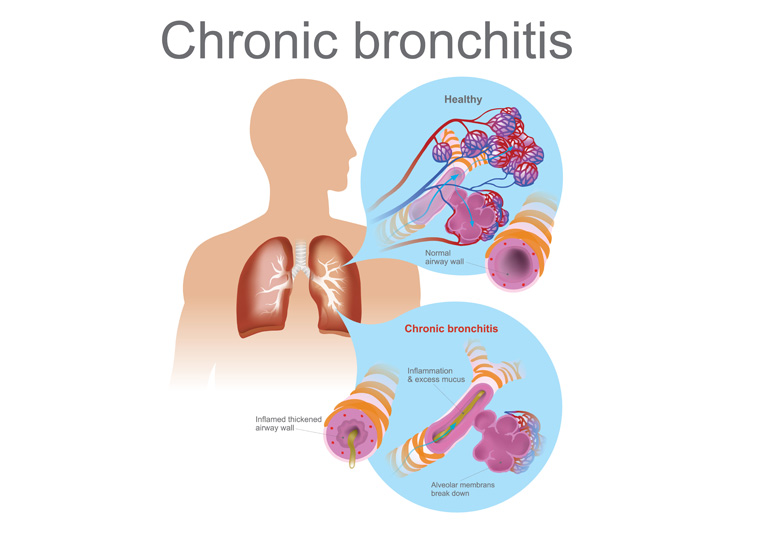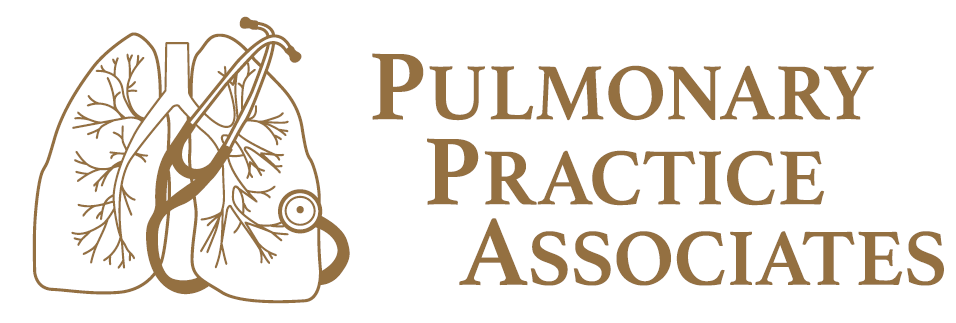Chronic Bronchitis

What Is Chronic Bronchitis?
Bronchitis is an inflammation of the lining of the bronchial tubes. These are the tubes that carry air to and from your lungs. People who have bronchitis often have a persistent cough that brings up thickened, discolored mucus. They may also experience wheezing, chest pain, and shortness of breath.
Bronchitis may be either acute or chronic. Acute bronchitis develops from a cold or other respiratory infection, and often improves within a few days without lasting effects. Chronic bronchitis is a more serious condition that develops over time rather than striking suddenly. It’s characterized by recurrent episodes of bronchitis that last for several months or years. The constant inflammation in the lining of the bronchial tubes causes excessive amounts of sticky mucus to build up in the airways. This restricts the amount of airflow going into and out of the lungs. The blockage in airflow gets worse over time, resulting in breathing difficulties and increased mucus production in the lungs.
Many people who have chronic bronchitis eventually develop emphysema, which is a type of lung disease. Together, the two conditions are referred to as chronic obstructive pulmonary disease, or COPD. According to the American Lung Association, more than 11 million people in the United States have COPD. However, there are many more people who don’t even know they have it.
The majority of COPD symptoms take a while to develop, so people often mistakenly believe that the condition isn’t life-threatening and ignore the symptoms until the condition has progressed to a more advanced stage. Although the condition can’t be cured, the symptoms can be managed with treatment once a diagnosis is made.
What Are the Symptoms of Chronic Bronchitis?
After a long period of inflammation and irritation in the bronchial tubes, chronic bronchitis can result in several hallmark symptoms, including a persistent, heavy cough that brings up mucus from the lungs. The mucus may be yellow, green, or white.
As time passes, the amount of mucus gradually increases due to the increased production of mucus in the lungs. The mucus eventually builds up in the bronchial tubes and restricts airflow, causing breathing to become increasingly difficult. This shortness of breath may be accompanied by wheezing that gets worse during any type of physical activity.
Other symptoms of chronic bronchitis may include:
- fatigue
- a fever
- chills
- chest discomfort
- sinus congestion
- bad breath
In the later stages of chronic bronchitis, the skin and lips may develop a bluish color due to a lack of oxygen in the bloodstream. Decreased levels of oxygen in the blood can also lead to peripheral edema, or swelling in the legs and ankles.
As chronic bronchitis progresses, the symptoms can also vary in severity and frequency. For example, a cough may disappear temporarily, only to be followed by a period of more intense coughing. More severe episodes may be triggered by various factors, including:
- respiratory tract infections, such as the cold or flu
- infections elsewhere in the body
- exposure to environmental irritants, such as air pollution or dust
- heart conditions
What Causes Chronic Bronchitis?
Chronic bronchitis occurs when the lining of the bronchial tubes repeatedly becomes irritated and inflamed. The continuous irritation and swelling can damage the airways and cause a buildup of sticky mucus, making it difficult for air to move through the lungs. This leads to breathing difficulties that gradually get worse. The inflammation can also damage the cilia, which are the hair-like structures that help to keep the air passages free of germs and other irritants. When the cilia don’t work properly, the airways often become a breeding ground for bacterial and viral infections.
Infections typically trigger the initial irritation and swelling that lead to acute bronchitis. Chronic bronchitis, however, is most commonly caused by cigarette smoking. In fact, over 90 percent of those with the disease have a history of smoking. Inhaling cigarette smoke temporarily paralyzes the cilia, so frequent smoking over an extended period can severely damage the cilia. Chronic bronchitis may develop over time due to this damage.
Secondhand smoke can also contribute to the development of chronic bronchitis. Other possible causes include extended exposure to air pollution, industrial or chemical fumes, and toxic gases. Repeated lung infections may also cause further damage to the lungs and make chronic bronchitis symptoms worse.
When Should I See My Doctor?
Many people dismiss symptoms of chronic bronchitis, believing they simply have smoker’s cough. However, it’s important to contact your doctor right away if you have even the slightest suspicion that you might have bronchitis. Failing to receive timely treatment for chronic bronchitis greatly increases your risk of severe lung damage, which can lead to respiratory problems or heart failure.
Call your doctor right away if your cough:
- lasts longer than three weeks
- prevents you from sleeping
- is accompanied by a fever above 100.4°F
- produces discolored mucus or blood
- causes wheezing or shortness of breath
How Is Chronic Bronchitis Diagnosed?
If you’re uncertain about whether or not your symptoms are those of chronic bronchitis, tests are available to help your doctor make a definitive diagnosis:
- A chest X-ray can help rule out other lung conditions, such as pneumonia, that may be causing your cough.
- Sputum is the mucus that you cough up from your lungs. Testing and analyzing the sputum can confirm the presence of bacteria and help your doctor determine the underlying cause of your symptoms.
- A pulmonary function test allows your doctor to evaluate how well your lungs are functioning. It can check for signs of asthma or emphysema by measuring how well you’re able to breathe and how easily your lungs are able to send oxygen to the rest of your body.
- During a CT scan, your doctor takes high-resolution X-rays of your body from various angles, allowing your doctor to see your lungs and other organs in more detail.
How Is Chronic Bronchitis Treated?
Although there’s no cure for chronic bronchitis, the disease can be managed with medical treatment and lifestyle adjustments, especially when a diagnosis is made early on.
Medical Treatments
Depending on the severity of your condition, your treatment plan may consist of the following:
- A bronchodilator is a type of medicine that opens the airways in your lungs, making it easier to breathe. The substance is usually breathed in through an inhaler, which is a device that pumps the medicine into your lungs. Your doctor will show you how to use your inhaler properly so you get the most from bronchodilator.
- Theophylline is an oral medication that relaxes the muscles in your airways so they open up more, which helps relieve any breathing difficulties. Your doctor may prescribe theophylline if you have severe shortness of breath.
- If your symptoms don’t improve with bronchodilator or theophylline, your doctor might prescribe steroids. These medications can be taken either with an inhaler or in pill form.
- Pulmonary rehabilitation is a program that is meant to improve your breathing and overall well-being. It often consists of exercise, nutritional counseling, and breathing strategies. Some programs also include counseling. Your doctor may refer you to a pulmonary rehabilitation program at a hospital in your area.
Lifestyle Remedies
Making certain lifestyle changes and trying natural remedies can also help alleviate the symptoms of chronic bronchitis. You may want to consider the following:
- Breathing in warm, moist air from a humidifier can ease coughs and loosen the mucus in your airways. Make sure you clean the humidifier regularly according to the manufacturer’s instructions. Bacteria and fungi can grow in the water container if it isn’t cleaned properly.
- You should quit smoking immediately if you’re smoker.If you live in an area with high levels of air pollution, you should wear a mask whenever you go outside. You should also wear a mask if you work in an industry where you’re exposed to paint or household cleaners with strong fumes. Frequent exposure to these irritants can make your symptoms much worse.
- Physical activity can strengthen the muscles that help you breathe. Ideally, you should exercise at least three times per week for 30 minutes. If you didn’t work out before, start out slowly and gradually increase the length and intensity of your exercise routine. You can ask your doctor to help you create an exercise plan that works for you.
- Pursed-lip breathing can sometimes provide relief when you’re having difficulty breathing. In pursed-lip breathing, you take a deep breath and then slowly breathe out through your mouth. As you breathe out, hold your lips as if you’re about to kiss someone. Doing this can help regulate your breathing and make you feel better when you’re experiencing shortness of breath.
How Can Chronic Bronchitis Be Prevented?
The most important thing you can do to reduce your risk for chronic bronchitis is to avoid or stop smoking. Severe lung damage can occur when you inhale cigarette smoke over an extended period. Once you quit smoking, your lungs will begin to heal and you’ll be able to breathe much easier. You’ll also lower your risk of getting lung cancer. Talk to your doctor about quitting smoking or visit the American Lung Association website for tips.
It’s also important to avoid other lung irritants, including paint, toxic fumes, and dust. If you work in an industry where you’re frequently exposed to such irritants, wear a mask over your nose and throat to protect your lungs.


